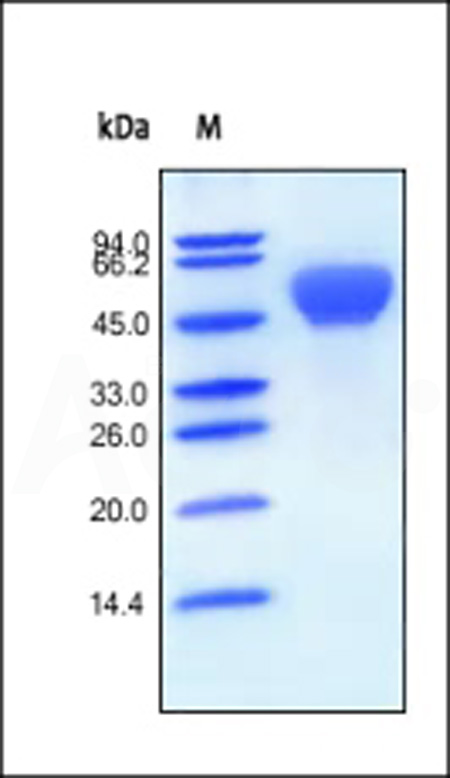分子别名(Synonym)
BMPR-1A,ALK-3,ACVRLK3,CD292,SKR5
表达区间及表达系统(Source)
Human BMPR-1A, Fc Tag (AL3-H5259) is expressed from human 293 cells (HEK293). It contains AA Gln 24 - Arg 152 (Accession # P36894-1).
Predicted N-terminus: Gln 24
Request for sequence
蛋白结构(Molecular Characterization)

This protein carries a human IgG1 Fc tag at the C-terminus.
The protein has a calculated MW of 40.3 kDa. The protein migrates as 56 kDa under reducing (R) condition (SDS-PAGE) due to glycosylation.
内毒素(Endotoxin)
Less than 1.0 EU per μg by the LAL method.
纯度(Purity)
>98% as determined by SDS-PAGE.
制剂(Formulation)
Lyophilized from 0.22 μm filtered solution in 50 mM Tris, 100 mM Glycine, pH7.5. Normally trehalose is added as protectant before lyophilization.
Contact us for customized product form or formulation.
重构方法(Reconstitution)
Please see Certificate of Analysis for specific instructions.
For best performance, we strongly recommend you to follow the reconstitution protocol provided in the CoA.
存储(Storage)
For long term storage, the product should be stored at lyophilized state at -20°C or lower.
Please avoid repeated freeze-thaw cycles.
This product is stable after storage at:
- -20°C to -70°C for 12 months in lyophilized state;
- -70°C for 3 months under sterile conditions after reconstitution.
电泳(SDS-PAGE)

Human BMPR-1A, Fc Tag on SDS-PAGE under reducing (R) condition. The gel was stained with Coomassie Blue. The purity of the protein is greater than 98%.
背景(Background)
The bone morphogenetic protein receptor, type IA is also known as BMPR1A or ALK3 is a protein which in humans is encoded by the BMPR1A gene. BMPR1A has also been designated as CD292 (cluster of differentiation 290). The bone morphogenetic protein (BMP) receptors are a family of transmembrane serine/threonine kinases that include the type I receptors BMPR1A (this protein) and BMPR1B and the type II receptor BMPR2. These receptors are also closely related to the activin receptors, ACVR1 and ACVR2. Alk3-mediated BMP signaling in AV endocardial/mesenchymal cells plays a central role during cushion morphogenesis.























































 膜杰作
膜杰作 Star Staining
Star Staining











